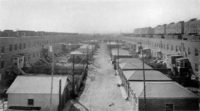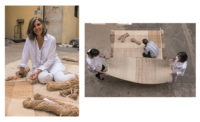IV
Let us grant, then, the mechanical advantages of the mass-house; and along with this its practicability. We must now ask another question: to what extent would the mass-production of such houses be a solution of the housing problem, and how far would this form of manufacture meet all the needs that are involved in the dwelling house and its communal setting? Those who talk about the benefits of mass-production have been a little misled, I think, by the spectacular success of this method in creating cheap motor cars; and I believe they have not sufficiently taken into account some of its correlative defects. Let us consider a few of these.
First of all: the great attraction of the manufactured house is the promise not only of efficiency but of cheapness, due to the competitive production of houses in large quantities. It is doubtful if this will prove to be a great element in reducing the cost of housing. The reason is simple. The shell of the building is not the largest element in the cost; the cost of money, the rent of land, the cost of utilities, including streets, mains, sewers and sewage disposal plants, are among the major items on the bill.
The two new spots where mass production would take the place of present methods, namely, in the shell itself, and in the assemblage of the parts, offer only a minor field for reductions. To cut the cost of the shell in half is to lower the cost of the house a bare ten per cent. The New York State Housing and Regional Planning Commission has shown that the lowering of the interest rate one per cent would effect as great a reduction; and the lowering of it to the level justified by the safety and durability of housing investments would reduce the costs far more drastically than the most ingenious cheese-paring on the structure.
Moreover, with respect to the other parts of the house, the fixtures, the mechanical apparatus, the finish, it remains true that while slight economies are possible through further standardization, a good part of these items is already produced by mass-methods--and most of the possible economies have been wrung out. Novelties in plan or design, such as those suggested in the Dymaxion house, should not obscure the fact that the great change in the shell is only a little change in the building as a whole. For lack of proper cost accounting our experimental architects have been butting their heads against this solid wall for years; but there is no reason why they should continue.
Land, manufactured utilities, site-improvements, and finance call for a greater share of the cost than the "building" and labor. Mass production will not remedy this. To use cesspools instead of sewers, artesian wells instead of a communal water system, and cheap farming land instead of urban land, as some of the advocates of the manufactured house have suggested, is merely to camouflage the problem: and it is more than a little naive: for such expedients are temporary dodges, which may occasionally be favored by a sandy soil or inaccessibility to traffic, but they cannot count for two pins in any comprehensive and universal solution of the housing problem.
There are many districts where an artesian well would cost as much as the house itself; and except in a communist society there are no spots on the earth where the Law of Rent is not operative--so that any large movement towards the open land, such as is now taking place fifty miles from New York, is immediately recorded in a conversion of farmland into building lots, with a swift rise in price. In short: the manufactured house cannot escape its proper site costs and its communal responsibilities.
The second hole in the program is the fact that mass-production brings with it the necessity for a continuous turnover. When mass-production is applied to objects that wear out rapidly, like shoes or rubber tires, the method may be socially valuable, although the late Thorstein Veblen has shown that some of these potential economies are nullified by the commercial habit of weakening the materials in order to hasten the pace of destruction. When, however, mass methods are applied to relatively durable goods like furniture or houses, there is great danger that once the original market is supplied, replacements will not have to be made with sufficient frequency to keep the original plant running.
Our manufacturers of furniture and motors are driven desperately to invent new fashions in order to hasten the moment of obsolescence; beyond a certain point, technical improvements take second place and stylistic flourishes enter. It will be hard enough, in the depraved state of middle class taste, to keep our mass houses from being styled in some archaic fashion, pseudo-Spanish or pseudo-Colonial, as the fad of the day may be; and once mechanical improvements bring diminishing returns this danger will be a grave one.
There is still another defect in the manufactured house, just the opposite of the tendency to foist new style, in order to increase the turnover. One might call this the model T dilemma. Mass-production, just because it involves the utmost specialization in labor-saving machinery and the careful interlinkage of chain processes, suffers, as I have pointed out elsewhere, from rigidity, from premature standardization. When the cheapening of the cost is the main object, mass production tends to prolong the life of designs which should be refurbished. In the case of the dwelling house, the continuance of obsolete models would possibly be as serious as the rapid alterations of style; and it is hard to see how mass production can avoid either one or the other horn of this dilemma.
V
What, then, is the conclusion? So far as the manufactured house would base its claim upon its social value, that is, upon the possibility of lowering the cost of housing to the point where new and efficient dwellings could be afforded by the owners of Ford cars, its promises are highly dubious. Granting every possible efficiency in design or manufacture, the mass-house, without any site attachments, would still represent an expenditure of from six to ten times the amount invested in automobiles of similar grade; and this leaves us pretty much in our present dilemma.
The new houses might well be better than the present ones--they could scarcely be worse. But, if better, they would not be radically cheaper, and since a new cost, a cost that is excessive in the motor industry, namely competitive salesmanship, would be introduced, the final results promise nothing for the solution of our real housing problem--the housing of the lower half of our income groups, and particularly, of our unskilled workers. The manufactured house no more faces this problem than the semi-manufactured house that we know today.
This does not mean that the processes of manufacture will not continue to invade the modern house; nor does it mean that the architect's present position in relation to the problem is a happy one. The question is whether he is able to devise an approach to the housing problem and to house design which will bring with it all the efficiencies promised by the Brothers Rasch or by Mr. Buckminster Fuller, and which will at the same time give scope to the particular art and technique of which he is master.
Is there perhaps a more radical approach to the problem of housing than the engineer and the mechanically-minded architect have conceived? I think there is; for though Mr. Fuller for example believes that he has swept aside all traditional tags in dealing with the house, and has faced its design with inexorable rigor, he has kept, with charming unconsciousness, the most traditional and sentimental tag of all, namely, the free-standing individual house. If we are thorough enough in our thinking to throw that prejudice aside, too, we may, I suspect, still find a place for the architect in modern civilization. I shall deal with the alternative to the purely mechanical solution of our problem in a second article.













